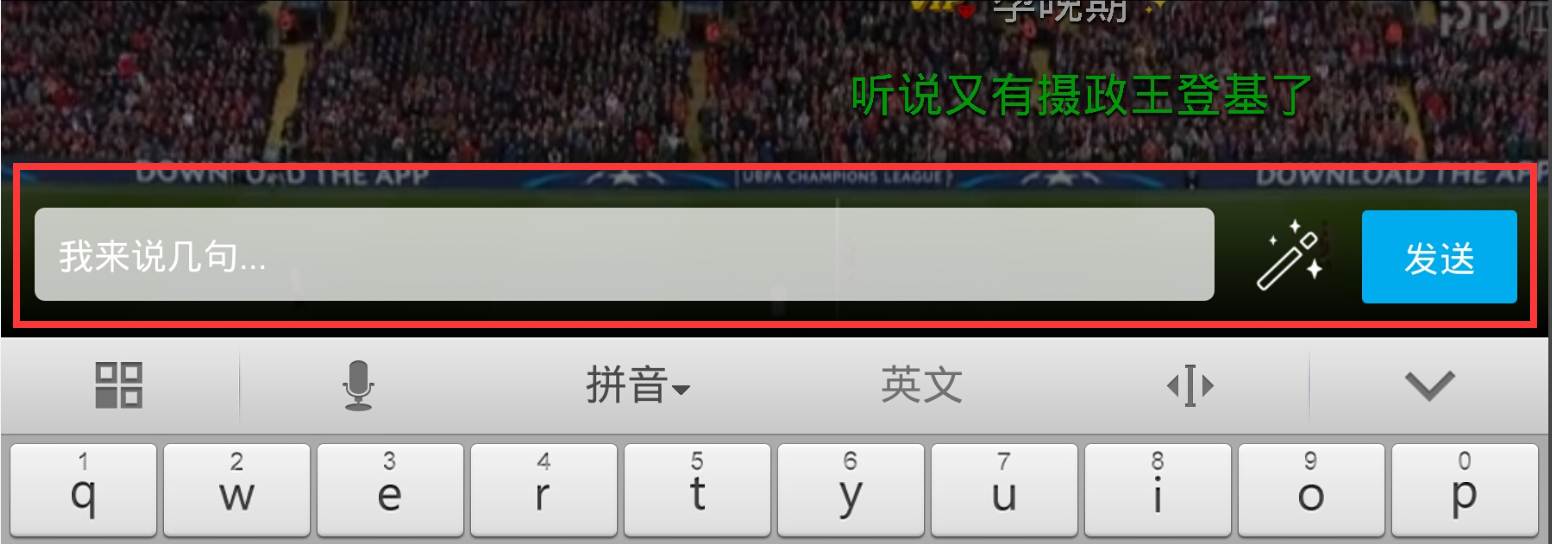做弹幕开发的时候有时候需要一个弹幕输入的界面是必不可少的;下面我们通过一个自定义Dialog快速实现这一功能,效果就像下面这样;
这种界面自己动手在xml布局里面很难搞,几乎弄不了,特别很难入手,一时也很懵逼,群里看到有人说用Dilaog来实现,就可以;果然使用Dialog很快就实现了;
思路是这样:
1,首先自定义一个Dialog ,Dialog里面包含EditText和Button
2,,实现里面的逻辑 点击发送的时候界面自动弹出且不全屏,点击Dialog会消失;
封装代码如下所示:
/**
* Created by shion on 2017/9/26.
* 弹幕发射的Dialog
*/
public class DanMaKuSendDialog extends Dialog implements
DialogInterface.OnShowListener,
DialogInterface.OnDismissListener,
DialogInterface.OnCancelListener {
private static final String TAG = DanMaKuSendDialog.class.getSimpleName();
/**
* @param context 上下文
* @param theme 主题样式
* @param width Dilaog的宽度
* @param height Dialog的高度
* @param resLayout Dialog 的布局layout资源id
* @param gravity Dialog在Window中的方向位置
* @param animation Dialog展示和隐藏时候的动画效果
*/
private DanMaKuSendDialog(Context context, int theme, int width, int height, int resLayout, int gravity, int animation) {
super(context, theme);
Window window = getWindow();
if (window != null) {
//设置布局
setContentView(resLayout);
//设置Dialog的其他属性
WindowManager.LayoutParams lp = window.getAttributes();
lp.width = width;//赋值宽度
lp.height = height;//赋值高度
lp.gravity = gravity;//赋值方位
window.setAttributes(lp);
//设置Dialog的动画效果
window.setWindowAnimations(animation);
}
}
private InputMethodManager imm;
private EditText mDialogEditText;
private TextView mDialogTextView;
public DanMaKuSendDialog(Context context) {
this(context, R.style.dialog_style_send_danmu, ViewGroup.LayoutParams.MATCH_PARENT, ViewGroup.LayoutParams.WRAP_CONTENT, R.layout.dialog_edit_view, Gravity.BOTTOM, 0);
//初始化软键盘服务管理类
imm = (InputMethodManager) context.getSystemService(Context.INPUT_METHOD_SERVICE);
//设置点击Dialog外部会消失 ,下面两个设置效果会回调onCancel --onDismiss方法,我们在里面关闭一下软键盘
setCanceledOnTouchOutside(true);
//点返回键Diloag会消失
setCancelable(true);
//初始化布局UI
mDialogTextView = (TextView) findViewById(R.id.tv_send);
mDialogEditText = (EditText) findViewById(et_keywored);
// 使软键盘不全屏显示,只占用一部分屏幕,对应xml标签 android:imeOptions="flagNoExtractUi
mDialogEditText.setImeOptions(EditorInfo.IME_FLAG_NO_EXTRACT_UI);
//初始化Dialog的监听
setOnShowListener(this);
setOnDismissListener(this);
setOnCancelListener(this);
}
//Dialog出现的时候监听 ,Dialog展示的时候就弹出软键盘
@Override
public void onShow(DialogInterface dialog) {
Log.e(TAG, "----Dialog----onShow-----------");
if (mDialogEditText != null) {
mDialogEditText.post(new Runnable() {
@Override
public void run() {
if (imm != null) {
imm.toggleSoftInput(InputMethodManager.SHOW_IMPLICIT, 0);
}
try {
Thread.sleep(60);
} catch (InterruptedException e) {
e.printStackTrace();
}
}
});
}
}
//Dialog消失的时候监听
@Override
public void onDismiss(DialogInterface dialog) {
Log.e(TAG, "----Dialog----onDismiss-----------");
}
//取消Dialog的监听 取消的时候关闭软键盘
@Override
public void onCancel(DialogInterface dialog) {
Log.e(TAG, "----Dialog----onCancel-----------");
if (mDialogEditText != null) {
mDialogEditText.post(new Runnable() {
@Override
public void run() {
if (imm != null) {
imm.toggleSoftInput(InputMethodManager.SHOW_IMPLICIT, InputMethodManager.HIDE_NOT_ALWAYS);
}
try {
Thread.sleep(60);
} catch (InterruptedException e) {
e.printStackTrace();
}
}
});
}
}
}
Dialog的主体style如下:
<!--自定义Dialog的主体样式-->
<style name="dialog_style_send_danmu" parent="@android:style/Theme.Dialog">
<!--对话框无标题-->
<item name="android:windowNoTitle">true</item>
<!--对话框边框-->
<item name="android:windowFrame">@null</item>
<!--对话框是否有遮盖层-->
<item name="android:windowContentOverlay">@null</item>
<!--对话框是否透明-->
<item name="android:windowIsTranslucent">true</item>
<!--对话框是否浮动,不浮动的话,就会固定在某个位置,对话框布局里有EditText时候也不会动-->
<item name="android:windowIsFloating">true</item>
<!--Dialog是否让对话框背景变暗-->
<item name="android:backgroundDimEnabled">false</item>
<!--对话框的背景-->
<item name="android:windowBackground">@android:color/transparent</item>
</style>
当然自己也可以自定义Dialog的动画效果style:
<!--定义Diloag的动画-->
<style name="anim_style_danmu">
<item name="android:windowEnterAnimation">@anim/dialog_danmu_in</item>
<item name="android:windowExitAnimation">@anim/dialog_danmu_out</item>
</style>以上就是主要代码,不做解释了注释也很清楚,完整代码下载:
Android自定义Dialog--DanmakuFllame弹幕发送框界面的实现

